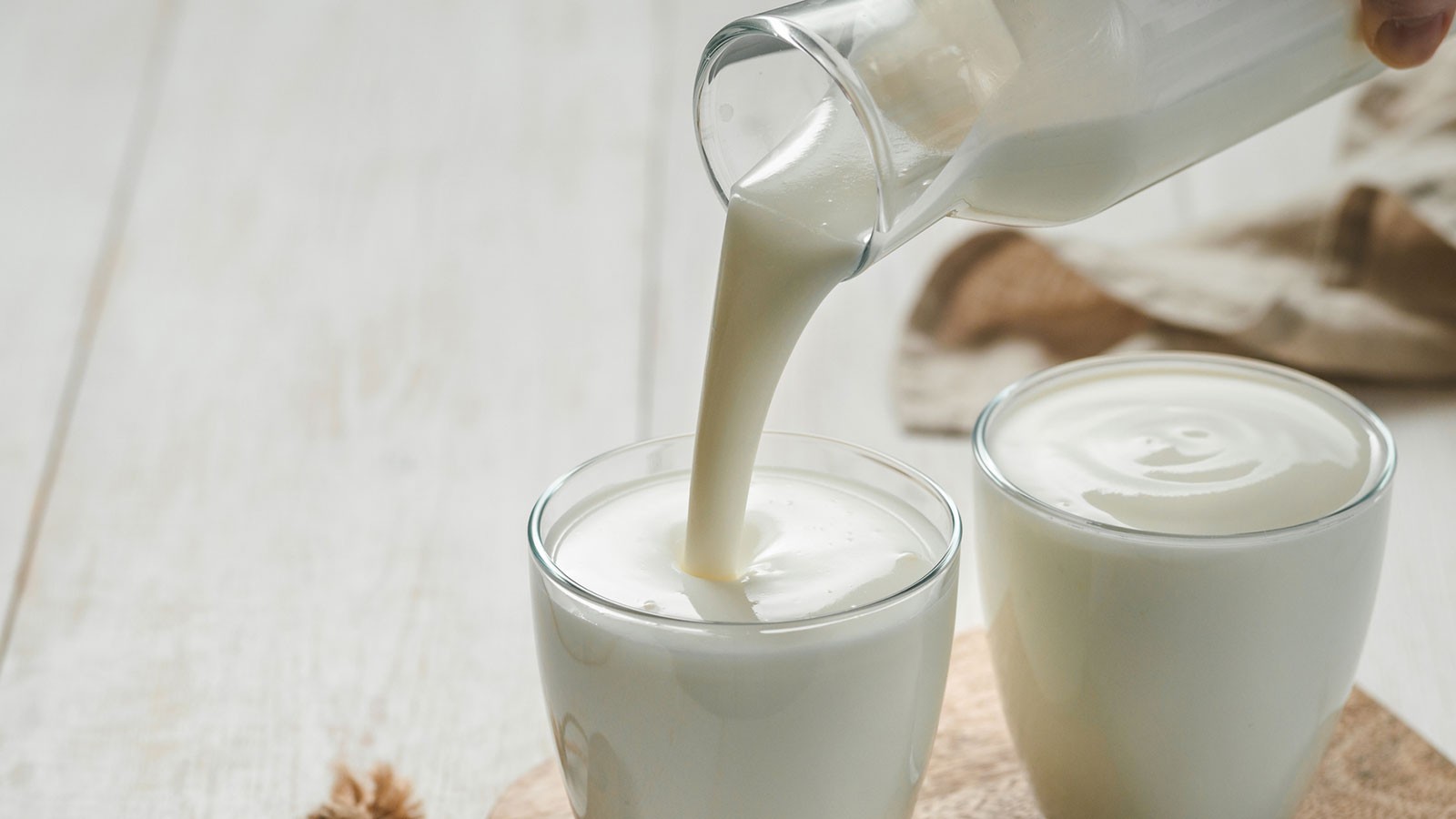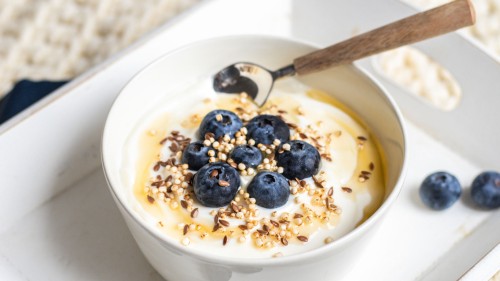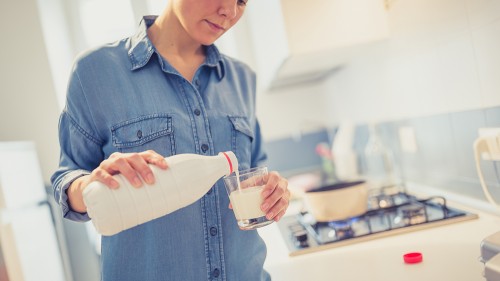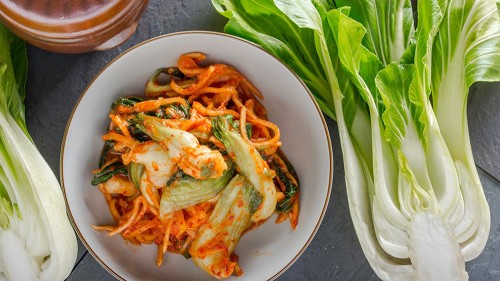WellnessVerge is reader-supported. We may earn a commission when you make a purchase through the links on this page. Learn more about our process here.
15 Probiotic Foods to Add to Your Diet That a Dietitian Recommends
Last Updated on December 16, 2021
Medically Reviewed by Anthony Dugarte, MD
Probiotics don’t just come in capsules or powders. There are plenty of probiotic foods you can incorporate into your diet for digestive health benefits. Understanding what foods naturally contain probiotics can help you plan for meals and snacks that include them regularly.


Why Eat Probiotic-Rich Foods?
Probiotics are live microorganisms that help populate the good bacteria in your digestive tract. This is called your gut microbiome. (1)
Because so much of our overall health depends on the health of our gut, it’s important to practice habits that support an optimal balance of good, health-promoting bacteria.
Additionally, probiotics may have specific benefits for your mental health, skin, digestion, and heart. (2, 3, 4, 5)
Research also suggests that probiotics have benefits for your immune system, so it makes sense that optimizing the health of your gut is a good place to focus. (6)
While there are plenty of probiotic supplements to choose from, these aren’t the only ways to help boost the good bacteria of your gut.
Eating foods naturally rich in probiotics is an easy way to introduce healthy bacteria regularly.
While the research on specific probiotic foods and their health benefits is still limited in humans, the general consensus is that they’re worth a shot, given their potential positives and overall low risk for harmful effects.
Fortunately, probiotic-rich foods are generally easy to find in most supermarkets and are typically in the refrigerated section.
To be considered a true probiotic food, the Food and Agricultural Organization and World Health Organization require that the microorganism strains being used meet the following four criteria: (7)
- They are sufficiently characterized
- They are safe for the intended use
- They are supported by at least one positive and scientifically robust human clinical trial
- They are alive in the product at an efficacious dose throughout shelf life
You can choose from a variety of probiotic foods as you decide which ones would fit best into your lifestyle and meet your needs.
Foods with Probiotics in Them
Foods that contain probiotics have been fermented. (8)
This means that they have undergone fermentation, a process of naturally preserving food that uses microorganisms like bacteria and yeast to convert carbohydrates into alcohol or acids.
To be fermented, these foods contain microorganisms that are generally either sourced from a starter culture or through what’s called spontaneous fermentation. (9)
The latter just means that the yeast and bacteria are left to ferment with whatever organisms are present in the environment at the time they come in contact with the liquid being used.
The end result typically contains several strains of bacteria, even more than were there to begin with.
Fermented foods tend to have a similar tartness to their flavor from the acids. It’s this process of fermentation that gives these foods their often wide range of probiotics.
Some of the best food sources of probiotics include:
1. Kefir
Kefir is a fermented probiotic milk beverage that resembles drinkable yogurt.
It’s made by adding kefir grains to dairy milk and, as a result, contains several potent strains of gut-friendly bacteria. (10)
In the United States, cow’s milk is most commonly used, but in other parts of the world, kefir may also be made with camel or goat milk.
Unlike yogurt, kefir is a much thinner and more drinkable liquid.
Plain kefir has a pretty tart flavor, so some manufacturers add sweetening agents like fruit or vanilla. It’s often sold near the yogurt in stores, and many people enjoy it for breakfast or a snack.
Kefir is typically fermented at room temperature and uses both yeast and bacteria in this process.
In its end form, kefir contains over 50 species of probiotic bacteria and yeast. (11)
It’s been shown to offer numerous gut health benefits, such as its ability to help alleviate constipation and offer antimicrobial activity. (12)
Summary
Kefir is a thin yogurt drink rich in many species of probiotics.
2. Kombucha
A fermented tea beverage, kombucha is most often made with a green or black tea base. Kombucha is carbonated and often has a fruity and slightly acidic flavor.
It’s made by adding a SCOBY, which stands for “symbiotic colony of bacteria and yeast,” to the tea. Bits of SCOBY are often found at the bottom of commercial kombucha bottles, which some people say resembles a glob of slime. (13)
While more clinical research in humans is needed, animal studies have found that kombucha consumption can help improve the gut bacterial composition in mice. (14)
Note that some kombucha can be high in sugar, so be sure to read the ingredient label if this is important for you.
Summary
Kombucha is a fermented tea beverage made by fermenting tea with fruit.
3. Natto
A traditional Japanese soy product, natto is a sticky, slimy, and strong-smelling food made from soybeans fermented with Bacillus subtilis bacteria.
It’s generally eaten topped with condiments like soy sauce or mustard, as well as chives or other seasonings. It’s most often served over cooked rice.
Some animal studies have shown that natto consumption is more beneficial for the gut microbiome than regular unfermented soybeans. (15)
Per gram, natto can contain between 1 million and 1 billion colony-forming bacteria (CFUs), which is significantly more than many probiotic supplements. (16)
Summary
Natto, a product made from soy with a strong flavor, is rich in probiotics.
4. Miso
Miso is a salty paste most often used as a soup seasoning in Japanese culture. It can be used anywhere you might use stock, or in place of salt or soy sauce in soups and sauces.
Miso is made by fermenting whole soybeans with salt and a fungus called koji. Koji is also used to make the Japanese alcoholic drink sake, as well as soy sauce.
There are three main types of miso:
- White miso, which has a sweeter and more subtle taste
- Red miso, which has a stronger umami flavor
- Awase miso, which is a combination of red and white
Probiotics from miso have been shown to improve digestive health in animal studies, suggesting that it may be a beneficial food for certain gut conditions, like inflammatory bowel diseases. (17)
Summary
Miso, a type of paste common in Japanese cooking, is also rich in probiotics.
5. Tempeh
Tempeh is made by adding a “tempeh starter” to soybeans. This starter contains spores of the fungus Rhizopus oligosporus. It acts as a trigger for the soybeans to ferment and bind together.
The end result is a firm, tan-colored patty with an earthy flavor with many versatile culinary uses.
Some research has shown that eating tempeh may influence the gut microbiome in humans, but more studies are needed. (9)
Many animal and lab studies have observed tempeh to have positive effects on inflammation, as well as offer antimicrobial activity.
Summary
Tempeh is made by adding a type of fungus to soybeans, which creates a nutrient and probiotic-rich patty.
6. Sauerkraut
Sauerkraut is a shredded cabbage that has been fermented with lactic acid-producing bacteria.
For the most possible benefit, it’s best to choose sauerkraut that states it is unpasteurized, as the pasteurization process would kill off any probiotic bacteria from the product.
While there’s overall limited evidence of human gut health benefits specific to sauerkraut, some research suggests it may have positive effects on the severity of irritable bowel syndrome. (9)
Summary
Sauerkraut is fermented cabbage with many health benefits for gut health.
7. Yogurt
Made by milk that has been fermented with friendly bacteria, yogurt is one of the best and most commonly consumed sources of probiotics.
Yogurt uses Streptococcus thermophilus and Lactobacillus bulgaricus strains in its fermentation. The milk thickens into yogurt as a result of the lactic acid produced by these bacteria.
Be sure to choose varieties that state they have had live and active cultures added to them. This may include both dairy and non-dairy varieties and will be indicated on the ingredient list.
Summary
Yogurt is made by fermenting milk with healthy bacteria.
8. Kimchi
Kimchi is a spicy food typically made with Chinese cabbage, similar to sauerkraut, but may also include a mix of other veggies fermented with lactic acid bacteria.
It’s then flavored with other ingredients like chili, pepper, garlic, onion, ginger, salt, soy sauce, sesame seeds, and sometimes other foods like carrots or pears.
One study found that the potential of kimchi to improve the gut microbiome may be especially beneficial for people with obesity. (18)
It may also offer some immune support due to how it affects gut bacteria. (9)
In addition to probiotic benefits, kimchi is made with cruciferous vegetables, which have their own perks for gut health, thanks to their fiber content. (19)
Kimchi is often served as an appetizer or side dish, but can also be used in sandwiches, savory pancakes, and fried rice.
Summary
Kimchi is a traditional spicy Korean dish made by fermenting cabbage and flavored with spices.
9. Traditional Buttermilk
A true traditional type of buttermilk refers specifically to the leftover liquid from the process of making butter, which contains probiotics.
The acidic flavor of buttermilk is attributed to the production of lactic acid that occurs when bacteria consume milk sugar.
Most commercial buttermilk is not considered to be a good source of probiotics.
If you like experimenting in the kitchen, you might be interested in trying recipes for making your own cultured buttermilk using almond milk or whole milk.
Summary
Traditionally-made buttermilk is a good source of probiotics, but most commercially-made products do not contain healthy bacteria.
10. Pickles
Pickles are simply cucumbers that have been fermented in a solution of salt and water and left to ferment with their own sour lactic acid bacteria.
Some animal studies have found that probiotics in naturally fermented pickles can help stabilize gut bacteria among mice. (20)
Summary
Pickles are a probiotic-rich food commonly enjoyed as a condiment for sandwiches, burgers, hot dogs, and wraps, or eaten whole on the side.
11. Some Cheeses
While most cheeses are fermented, bacteria don’t always survive the aging process, so they are not all good sources of probiotics.
Choosing ones that state they contain live and active cultures can provide existing probiotics to your diet. These often include Gouda, mozzarella, and cheddar. (21, 22)
Summary
Being one of the most widely consumed and versatile foods, cheese is beloved by many people sandwiches and wraps, pizzas, pasta dishes, or as a snack served with fruit or nuts.
12. Sourdough Bread
Sourdough bread is fermented with the probiotic Lactobacillus. Unfortunately, most of its probiotic benefits are burned off during the baking process of the bread.
Still, cooking results in the production of lactic acid, which can help reduce the phytic acid content of sourdough. This may have digestive benefits because phytic acid is known to inhibit the absorption of certain minerals.
While sourdough is still a form of white bread, some studies have found that the fermentation process makes the fiber in the bread more bioavailable. (23)
This, in turn, offers some digestive health benefits by encouraging the growth of beneficial gut bacteria. (24)
For the most overall benefit from sourdough bread, look for one made using whole grains rather than white flour.
Summary
Sourdough bread has digestive benefits due to the addition of probiotics.
13. Cottage Cheese
Cottage cheese contains Lactobacillus casei.
It’s made by heating skim or nonfat milk with lactic acid-producing bacteria cultures, or an acid like lemon juice or vinegar.
This combination produces a reaction that causes the milk to curdle and parts of the mixture to separate.
Summary
Cottage cheese is made by adding probiotics or acid to milk.
14. Apple Cider Vinegar
Apple cider vinegar is made by fermenting apples.
Because it is a fermented food, it does contain good bacteria for your gut. However, apple cider vinegar itself may not have quite as many probiotic benefits as some of the other foods listed here. (25)
For the most gut health benefit, look for apple cider vinegar that contains the “mother,” or the thick layer of acetic acid bacteria on the vinegar’s surface. This is where most of the healthy bioactive substances are housed in apple cider vinegar. (26)
Summary
Apple cider vinegar is made by fermenting apples with certain types of probiotics.
15. Brine-Cured Olives
If you’re already a fan of olives, you’re familiar with their briny, acidic flavor.
Table olives are fermented with Lactobacillus bacteria, making them a probiotic food. (27)
Keep in mind that fermented or cured olives also tend to be quite high in salt, which may be best consumed in moderation, especially if you’re on a sodium-controlled diet or tend to eat a lot of other salty foods.
Summary
Olives are made by fermenting the olive fruit with probiotics.
What Probiotics Are in Foods?
The most common probiotics that you would find in fermented foods include various strains of Bifidobacteria, which are richest in dairy products like cheese, yogurt, and kefir, as well as lactic acid bacteria. (28)
Several chronic diseases seem to have a correlation with low numbers of Bifidobacteria in the intestines, such as celiac disease, dermatitis, obesity, diabetes, and allergic asthma. (29, 30, 31)
Bifidobacteria may also have benefits for mental health and inflammatory bowel conditions. (32, 33)
Bacillus subtilis is a specific bacterial strain found in natto that may stimulate immunity. (34)
Several strains of Lactobacillus are found in kimchi and may have benefits for immunity, inflammation, and digestive issues like diarrhea. (35, 36, 37)
Summary
Fermented foods contain many different types of probiotics that may have a variety of healthy benefits.
Vegan Sources of Probiotics
The list above contains several different types of foods.
You may be wondering whether they would be appropriate on a plant-based or vegan diet, which minimizes or excludes animal-derived foods like meat, eggs, and dairy products like milk and cheese.
The answer is that there are plenty of vegan probiotic foods.
From the list above, safe vegan choices include kombucha, natto, miso, tempeh, sauerkraut, kimchi, and pickles.
Plus, the fermentation process itself doesn’t add any animal-derived ingredients that would make these foods no longer vegan.
Of course, there are always variations of products, so it’s best to check the ingredient list to ensure no dairy milk or other animal ingredients have been added to the end product being sold.
Note that some stores may carry vegan versions of traditionally dairy-based kefir, yogurt, and cheese.
Summary
Always check the ingredient list to determine if a food is vegan and made with probiotic strains.
Prebiotics in Foods
If you’re thinking about adding probiotics to your diet, prebiotics can also be worth considering.
Probiotics and prebiotics may work synergistically to help bacteria crossing the upper part of the gastrointestinal tract survive and be more effective in the colon. (38)
Prebiotics are essentially the food for probiotics. They are a type of dietary fiber that helps your gut bacteria produce nutrients that benefit your digestive system. (39, 40)
Prebiotics are found in foods like:
- Dandelion greens
- Chicory root
- Garlic
- Jerusalem artichoke
- Onions
- Leeks
- Asparagus
- Barley
- Oats
- Apples
- Flaxseeds
Summary
Prebiotics are types of fiber found in plants that help feed the probiotics in food.
Tips for Adding More Probiotic-Rich Foods into Your Diet
With the wide variety of foods that offer probiotics comes many ways to enjoy them as part of your everyday diet.
This may mean adding something new to your routine or simply substituting a probiotic food for something else you normally eat.
For instance:
-
Try swapping out some of your go-to beverages that may offer fewer health benefits for fermented drinks. Enjoy an occasional kombucha in place of an energy drink, juice, or soda. While kombucha can still contain a lot of sugar, it offers other health benefits that the aforementioned beverages don’t.
-
Tempeh is a versatile plant protein that can be used in many of the same ways you might enjoy things like chicken or ground beef. It can be grilled and used on salads, sauteed with vegetables in a stir fry, or crumbled and cooked in the crockpot for vegan chili or sloppy joes. Note that tempeh can have a bitter flavor if you’re not used to it, so if this bothers you, you can reduce some of this by steaming the tempeh for a few minutes before preparing it.
-
Miso is a unique and robust flavor in the kitchen and tends to have a longer shelf-life, making it a good fridge staple. It works best to make miso soup or as a flavoring for rice and other grain dishes. You can also use miso to make tasty homemade sauces, dressings, or marinades by combining it with ingredients like soy sauce, ginger, garlic, oil, and citrus. Keep in mind that a little bit goes a long way when using miso. You’re probably only going to need a tablespoon or two in most recipes.
-
If you like beans and lentils, you might enjoy experimenting with natto. Natto is most popular as a Japanese breakfast food, but many people enjoy it in other ways. For example, you can spread natto on bread with veggies, chopped tomato, and cheese to make a pizza. Natto can also be fried in a pan, after which you drain the excess oil and eat it with a bit of soy sauce. Some people also like natto added to sticky rice or mixed with cubed avocado.
-
Acidic pickles and olives work well as part of a charcuterie board or are paired with things like crackers, cheese, and dates. You can layer pickles onto hot or cold sandwiches, or chop them into a relish for burgers and hot dogs.
-
Olives can be mixed into green salads, Mediterranean-inspired grain dishes, used as a homemade pizza topping, and even stuffed into sub sandwiches and wraps.
-
Yogurt and kefir make great ingredients for breakfast. Use them as the base for a berry and granola bowl or incorporate them into smoothies. Plain yogurt can also be used as a base for homemade creamy dips.
Summary
Probiotic-rich foods can be easily added to your diet in a variety of ways. Choose a few you like and enjoy them regularly.
Safety Considerations
Consuming fermented probiotic foods is considered safe for most healthy people.
However, if you’re not used to eating probiotic-rich food, it’s not uncommon to experience bloating and increased gas as an initial and temporary side effect, especially if the food is also high in fiber. (41)
It’s also important to note that while foods can also be fermented at home, this comes with more safety risks. (42)
Incorrect temperatures, using unsterile equipment or surfaces, or following the wrong fermentation times can lead to spoilage or contamination that makes the food unsafe.
Purchasing commercial fermented probiotic foods made in controlled, sterile environments can help reduce this risk.
If you are experiencing gastrointestinal distress or unusual symptoms, it’s best to speak to your doctor to ensure any underlying causes are properly addressed before adding probiotic foods or assuming these will resolve the issue.
Summary
Probiotic-rich foods are generally safe. If they are causing digestive problems, speak to your doctor.
The Bottom Line
How do you know if you would benefit from prebiotics and probiotics?
While more human research is needed on the benefits of specific types of probiotic foods, they are considered to offer potential benefits for most healthy people as part of their regular diet.
Plus, there are minimal safety concerns with adding probiotic foods to your lifestyle.
In other words, don’t just wait until you have stomach symptoms to start eating them, as you could be missing out on preventive benefits for your everyday digestive health.
Consuming probiotic foods can be as simple as adding some of these fermented items to your existing routine. Foods like pickles, yogurt, sauerkraut, and tempeh can be used in everyday ways.
You may also enjoy experimenting with less common foods like natto, miso, and kimchi to find new ways to use probiotics.
Whatever diet pattern you follow, there are plenty of probiotic-rich foods to choose from.
Enjoy the benefits of probiotics in ways that work best for you, and your digestive and overall health will thank you.
At WellnessVerge, we only use reputable sources, including peer-reviewed medical journals and well-respected academic institutions.
- Expert consensus document. The International Scientific Association for Probiotics and Prebiotics consensus statement on the scope and appropriate use of the term probiotic:
https://pubmed.ncbi.nlm.nih.gov/24912386/ - Gut brain axis: diet microbiota interactions and implications for modulation of anxiety and depression:
https://pubmed.ncbi.nlm.nih.gov/25448230/ - Probiotics and prebiotics in dermatology:
https://pubmed.ncbi.nlm.nih.gov/24906613/ - A meta-analysis of probiotic efficacy for gastrointestinal diseases:
https://pubmed.ncbi.nlm.nih.gov/22529959/ - Effect of probiotics on biomarkers of cardiovascular disease: implications for heart-healthy diets:
https://pubmed.ncbi.nlm.nih.gov/24330093/ - Effectiveness of probiotics on the duration of illness in healthy children and adults who develop common acute respiratory infectious conditions: a systematic review and meta-analysis:
https://pubmed.ncbi.nlm.nih.gov/24780623/ - Criteria to Qualify Microorganisms as "Probiotic" in Foods and Dietary Supplements:
https://pubmed.ncbi.nlm.nih.gov/32793153/ - Fermented Foods as a Dietary Source of Live Organisms:
https://www.ncbi.nlm.nih.gov/pmc/articles/PMC6117398/ - Fermented Foods: Definitions and Characteristics, Impact on the Gut Microbiota and Effects on Gastrointestinal Health and Disease:
https://www.ncbi.nlm.nih.gov/pmc/articles/PMC6723656/ - Microbiological, technological and therapeutic properties of kefir: a natural probiotic beverage:
https://pubmed.ncbi.nlm.nih.gov/24294220/ - Modern perspectives on the health benefits of kefir in next generation sequencing era: Improvement of the host gut microbiota:
https://pubmed.ncbi.nlm.nih.gov/29336590/ - Effects of Regular Kefir Consumption on Gut Microbiota in Patients with Metabolic Syndrome: A Parallel-Group, Randomized, Controlled Study:
https://www.ncbi.nlm.nih.gov/pmc/articles/PMC6769690/ - Chemical Profile and Antioxidant Activity of the Kombucha Beverage Derived from White, Green, Black and Red Tea:
https://www.ncbi.nlm.nih.gov/pmc/articles/PMC7278673/ - Effect of Kombucha on gut-microbiota in mouse having non-alcoholic fatty liver disease:
https://pubmed.ncbi.nlm.nih.gov/30815318/ - Fermented Soybean Suppresses Visceral Fat Accumulation in Mice:
https://pubmed.ncbi.nlm.nih.gov/29938903/ - Natto Characteristics as Affected by Steaming Time, Bacillus Strain, and Fermentation Time:
https://ift.onlinelibrary.wiley.com/doi/abs/10.1111/j.1365-2621.2001.tb15601.x - Novel probiotic yeast from Miso promotes regulatory dendritic cell IL-10 production and attenuates DSS-induced colitis in mice:
https://pubmed.ncbi.nlm.nih.gov/34213612/ - Intervention with kimchi microbial community ameliorates obesity by regulating gut microbiota:
https://pubmed.ncbi.nlm.nih.gov/32876915/ - Health benefits of kimchi (Korean fermented vegetables) as a probiotic food:
https://pubmed.ncbi.nlm.nih.gov/24456350/ - Lactobacillus fermentum CQPC06 in naturally fermented pickles prevents non-alcoholic fatty liver disease by stabilizing the gut-liver axis in mice:
https://pubmed.ncbi.nlm.nih.gov/32945305/ - Survival of microencapsulated probiotic Lactobacillus paracasei LBC-1e during manufacture of Mozzarella cheese and simulated gastric digestion:
https://pubmed.ncbi.nlm.nih.gov/22981567/ - Probiotic bacteria survive in Cheddar cheese and modify populations of other lactic acid bacteria:
https://pubmed.ncbi.nlm.nih.gov/24905221/ - Effect of sourdough fermentation and baking process severity on dietary fibre and phenolic compounds of immature wheat flour bread:
https://www.sciencedirect.com/science/article/abs/pii/S0023643817302980 - Fecal Metaproteomic Analysis Reveals Unique Changes of the Gut Microbiome Functions After Consumption of Sourdough Carasau Bread:
https://www.frontiersin.org/articles/10.3389/fmicb.2019.01733/full - Microorganisms in Fermented Apple Beverages: Current Knowledge and Future Directions:
https://www.ncbi.nlm.nih.gov/pmc/articles/PMC5620630/ - Bioactive components of mother vinegar:
https://pubmed.ncbi.nlm.nih.gov/25648676/ - Lactic acid bacteria from fermented table olives:
https://www.sciencedirect.com/science/article/abs/pii/S0740002012000238 - Bifidobacteria in milk products: An overview of physiological and biochemical properties, exopolysaccharide production, selection criteria of milk products and health benefits:
https://www.sciencedirect.com/science/article/abs/pii/S0963996913006121 - Imbalances in faecal and duodenal Bifidobacterium species composition in active and non-active coeliac disease:
https://pubmed.ncbi.nlm.nih.gov/19102766/ - Obesity in school-aged children and its correlation with Gut E.coli and Bifidobacteria: a case–control study:
https://www.ncbi.nlm.nih.gov/pmc/articles/PMC4448301/ - The relationship between bifidobacteria and allergic asthma and/or allergic dermatitis: a prospective study of 0-3 years-old children in Turkey:
https://pubmed.ncbi.nlm.nih.gov/24878320/ - A randomized controlled trial to test the effect of multispecies probiotics on cognitive reactivity to sad mood:
https://pubmed.ncbi.nlm.nih.gov/25862297/ - Lactobacillus and bifidobacterium in irritable bowel syndrome: symptom responses and relationship to cytokine profiles:
https://pubmed.ncbi.nlm.nih.gov/15765388/ - Probiotic strain Bacillus subtilis CU1 stimulates immune system of elderly during common infectious disease period: a randomized, double-blind placebo-controlled study:
https://pubmed.ncbi.nlm.nih.gov/26640504/ - Antioxidant and immune-enhancing effects of probiotic Lactobacillus plantarum 200655 isolated from kimchi:
https://pubmed.ncbi.nlm.nih.gov/30956861/ - Beneficial Effects of Kimchi, a Korean Fermented Vegetable Food, on Pathophysiological Factors Related to Atherosclerosis:
https://pubmed.ncbi.nlm.nih.gov/29271694/ - Inclusion of Fermented Foods in Food Guides around the World:
https://www.ncbi.nlm.nih.gov/pmc/articles/PMC4303846/ - Prebiotics and probiotics: are they functional foods?:
https://academic.oup.com/ajcn/article/71/6/1682S/4729644 - Bacterial metabolism and health-related effects of galacto-oligosaccharides and other prebiotics:
https://pubmed.ncbi.nlm.nih.gov/18215222/ - Prebiotics: Definition, Types, Sources, Mechanisms, and Clinical Applications:
https://pubmed.ncbi.nlm.nih.gov/30857316/ - Probiotics:
https://pubmed.ncbi.nlm.nih.gov/20208051/ - Fermentation and pathogen control: a risk assessment approach:
https://pubmed.ncbi.nlm.nih.gov/12382687/






